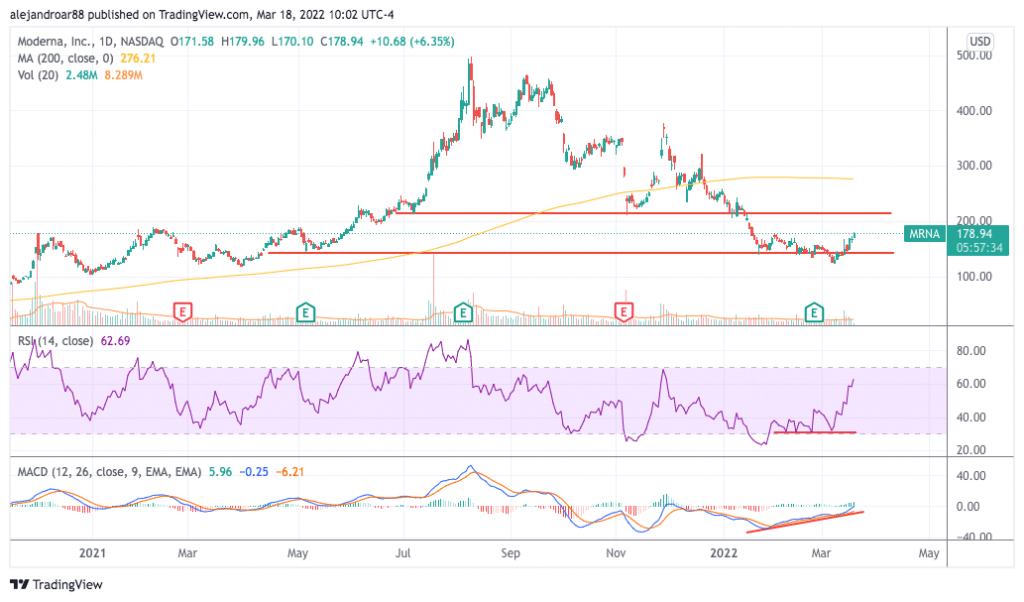Moderna Stock Up 10% in March – Time to Buy MRNA Stock?
Please note that we are not authorised to provide any investment advice. The content on this page is for information purposes only.
The price of Moderna stock is up 10% so far this month following news that Japan has placed a new order for millions of doses of COVID-19 vaccines from the biotech company along with other positive developments.
On 16 March, Reuters reported that the Asian country was ordering a combined total of 145 million doses of COVID-19 vaccines from both Pfizer (PFE) and Moderna to keep administering booster shots to the population. Later on, the company clarified that it will be responsible for supplying 70 million doses.
Meanwhile, Canada just approved the company’s vaccine to be administered to children aged between 6 to 11 years old. Additionally, Moderna announced this morning that it is seeking emergency-use approval with the US Food and Drug Administration (FDA) for a fourth dose of its COVID-19 vaccine – also known as Spikevax – for those who have received an initial booster shot of any FDA-approved vaccine.
Shares of Moderna are jumping 2.5% in pre-market stock trading action on the back of this development.
Other news that have prompted a short-term uptick in the price of this biotech stock include the appearance of thousands of COVID-19 cases in China and the beginning of a Phase 1 trial for the company’s HIV vaccine.
What could be expected from Moderna (MRNA) stock in light of these developments? In this article, I will be assessing its price action and fundamentals to outline plausible scenarios for the future.
67% of all retail investor accounts lose money when trading CFDs with this provider.
Moderna Stock – Technical Analysis

Moderna stock accumulates a 33.7% loss so far this year as an effective antiviral treatment against the COVID-19 virus is already being marketed by both Pfizer and Merck in multiple latitudes.
Meanwhile, as the number of vaccinated patients increases, market participants have been progressively pricing a deceleration in the firm’s top and bottom-line growth in the next few years.
The positive news cited above prompted a rebound in the price action in early March and shares have kept surging since then. Multiple areas of resistance stand in the way for Moderna stock including the $180, $190, and $210 levels.
Momentum indicators had been favoring a bullish near-term outlook for MRNA amid the appearance of a bullish divergence in both the Relative Strength Index (RSI) and the MACD in the past few weeks.
Trading volumes have been increasing in the past few days and this indicates that positive momentum could be picking up some steam.
However, with so many technical thresholds along the way, the upside potential for Moderna stock could be quite limited as none of the news cited previously constitute a change in the company’s fundamentals or growth prospects down the road.
Moderna Stock – Fundamental Analysis
Last year, Moderna reported total revenues of $18.5 billion along with GAAP net income and fully diluted earnings per share of 12.2 billion and $28.3 respectively.
By the end of this period, cash and equivalents ended at $17.6 billion while short-term investments finished the quarter at $5.2 billion for a combined total of $22.8 in liquid reserves.
The company said that it has signed advanced purchase agreements (APA) worth around $19 billion due in 2022 while it is actively discussing further purchases with multiple interested parties.
The Board of Directors also authorized a $3 billion share buyback program to substitute a fully executed $1 billion program that was entirely depleted in January 2022.
Estimates for 2022 from analysts see the firm’s revenues landing at $22.14 billion while the consensus forecast for the firm’s adjusted earnings per share is standing at $27.63. This results in forward P/S and P/E ratios of 3x and 6x respectively.
However, 2023 forecasts are more relevant when it comes to valuing Moderna as market participants are more focused on what the firm can do with its sizable cash reserves and how its pipeline evolves in a post-COVID scenario.
Based on analysts’ consensus estimates, Moderna’s sales and adjusted earnings per share are expected to land at $11.7 billion and $10.3 per share respectively by the end of that year. That results in a forward P/E ratio of 17x.
In 2021, Moderna generated free cash flows of around $13.3 billion resulting in an FCF margin of 72%. Assuming that the company will maintain a 70% FCF margin in 2023 and based on the market’s forecast for that period, Moderna could be generating up to $8.2 billion in free cash flows.
Based on the market capitalization of the company at the moment, this results in a forward P/FCF ratio of 8.6x.
Some of the most promising treatments within the company’s pipeline include a flu vaccine that is already entering Phase 3 trials along with a Zika and CMV vaccine that are also moving forward in the trialing process. The approval of any of these treatments by authorities could lead to changes in the market’s outlook for the firm’s top and bottom-line results.
From a fundamental perspective, the market might be adopting a very pessimistic attitude toward Moderna and might be disregarding the significant firepower that the firm now has with such liquid reserves at its disposal. Additionally, billions in cash will continue to flow into the business in the following 18 months or so.
These reserves give the company the chance to push forward all of the promising treatments within its pipeline while it has already proven that its mRna technology has the power to create effective treatments in record time.
Moreover, the management has also proven their ability to act rapidly and execute plans effectively and this is another positive aspect of the business that Wall Street could be ignoring and not pricing into the valuation accordingly.






